英语教学句子游戏.doc
- 格式:doc
- 大小:19.73 KB
- 文档页数:6
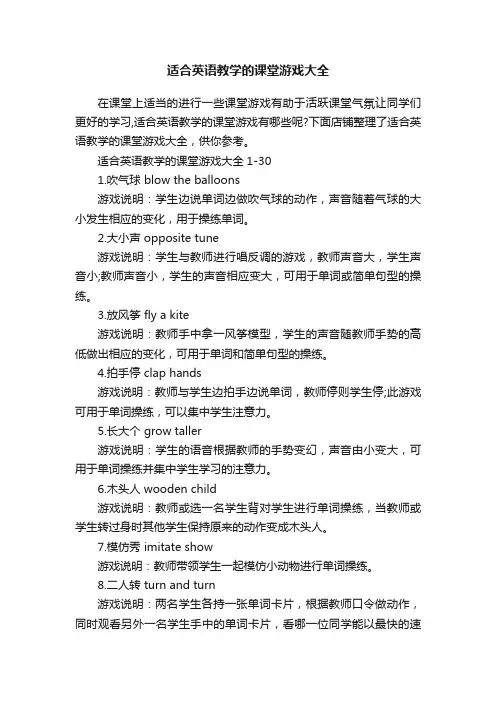
适合英语教学的课堂游戏大全在课堂上适当的进行一些课堂游戏有助于活跃课堂气氛让同学们更好的学习,适合英语教学的课堂游戏有哪些呢?下面店铺整理了适合英语教学的课堂游戏大全,供你参考。
适合英语教学的课堂游戏大全1-301.吹气球 blow the balloons游戏说明:学生边说单词边做吹气球的动作,声音随着气球的大小发生相应的变化,用于操练单词。
2.大小声 opposite tune游戏说明:学生与教师进行唱反调的游戏,教师声音大,学生声音小;教师声音小,学生的声音相应变大,可用于单词或简单句型的操练。
3.放风筝 fly a kite游戏说明:教师手中拿一风筝模型,学生的声音随教师手势的高低做出相应的变化,可用于单词和简单句型的操练。
4.拍手停 clap hands游戏说明:教师与学生边拍手边说单词,教师停则学生停;此游戏可用于单词操练,可以集中学生注意力。
5.长大个 grow taller游戏说明:学生的语音根据教师的手势变幻,声音由小变大,可用于单词操练并集中学生学习的注意力。
6.木头人 wooden child游戏说明:教师或选一名学生背对学生进行单词操练,当教师或学生转过身时其他学生保持原来的动作变成木头人。
7.模仿秀 imitate show游戏说明:教师带领学生一起模仿小动物进行单词操练。
8.二人转 turn and turn游戏说明:两名学生各持一张单词卡片,根据教师口令做动作,同时观看另外一名学生手中的单词卡片,看哪一位同学能以最快的速度认出另一位同学手中的卡片。
该游戏用于考查学生对单词的掌握程度。
9.运气球 pass the balloons游戏说明:两组学生边运气球边说单词,看哪组学生运球好,单词说的又流利。
10.传球、拍球 pass or bounce the ball游戏说明:请两组学生边传球边传单词或句子,看哪组同学传的又快又好,可用于单词或句型的分组操练。
11.和卡片跳舞 dance with cards游戏说明:教师手持卡片,学生根据教师手中卡片的变化做出相应的舞蹈动作,可用于单词的操练12.翘翘板 play on the see-saw游戏说明:教师与学生操练单词,但学生与教师做出相反的动作。
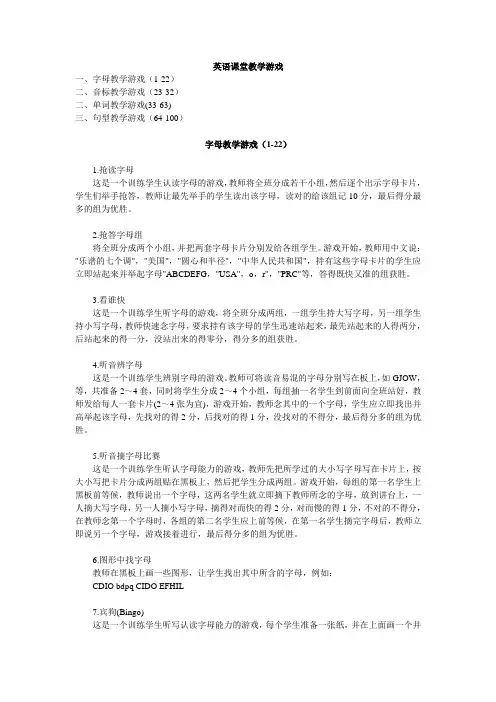
英语课堂教学游戏一、字母教学游戏(1-22)二、音标教学游戏(23-32)二、单词教学游戏(33-63)三、句型教学游戏(64-100)字母教学游戏(1-22)1.抢读字母这是一个训练学生认读字母的游戏,教师将全班分成若干小组,然后逐个出示字母卡片,学生们举手抢答,教师让最先举手的学生读出该字母,读对的给该组记10分,最后得分最多的组为优胜。
2.抢答字母组将全班分成两个小组,并把两套字母卡片分别发给各组学生。
游戏开始,教师用中文说:"乐谱的七个调","美国","圆心和半径","中华人民共和国",持有这些字母卡片的学生应立即站起来并举起字母"ABCDEFG,"USA",o,r","PRC"等,答得既快又准的组获胜。
3.看谁快这是一个训练学生听字母的游戏,将全班分成两组,一组学生持大写字母,另一组学生持小写字母,教师快速念字母,要求持有该字母的学生迅速站起来,最先站起来的人得两分,后站起来的得一分,没站出来的得零分,得分多的组获胜。
4.听音辨字母这是一个训练学生辨别字母的游戏。
教师可将读音易混的字母分别写在板上,如GJOW,等,共准备2~4套,同时将学生分成2~4个小组,每组抽一名学生到前面向全班站好,教师发给每人一套卡片(2~4张为宜),游戏开始,教师念其中的一个字母,学生应立即找出并高举起该字母,先找对的得2分,后找对的得1分,没找对的不得分,最后得分多的组为优胜。
5.听音摘字母比赛这是一个训练学生听认字母能力的游戏,教师先把所学过的大小写字母写在卡片上,按大小写把卡片分成两组贴在黑板上,然后把学生分成两组。
游戏开始,每组的第一名学生上黑板前等候,教师说出一个字母,这两名学生就立即摘下教师所念的字母,放到讲台上,一人摘大写字母,另一人摘小写字母,摘得对而快的得2分,对而慢的得1分,不对的不得分,在教师念第一个字母时,各组的第二名学生应上前等候,在第一名学生摘完字母后,教师立即说另一个字母,游戏接着进行,最后得分多的组为优胜。
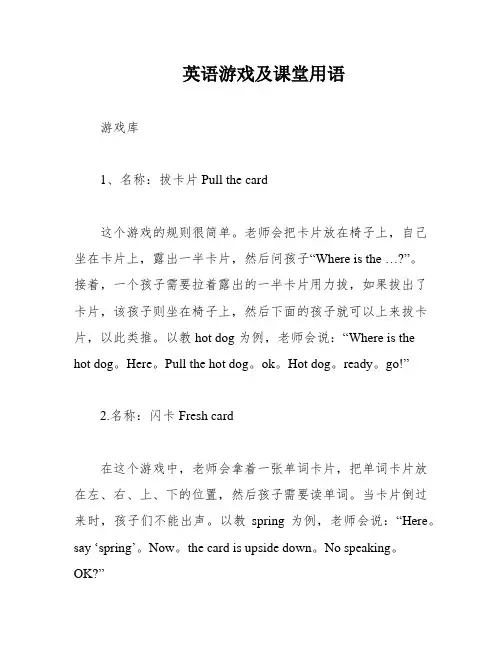
英语游戏及课堂用语游戏库1、名称:拔卡片 Pull the card这个游戏的规则很简单。
老师会把卡片放在椅子上,自己坐在卡片上,露出一半卡片,然后问孩子“Where is the …?”。
接着,一个孩子需要拉着露出的一半卡片用力拔,如果拔出了卡片,该孩子则坐在椅子上,然后下面的孩子就可以上来拔卡片,以此类推。
以教 hot dog 为例,老师会说:“Where is the hot dog。
Here。
Pull the hot dog。
ok。
Hot dog。
ready。
go!”2.名称:闪卡 Fresh card在这个游戏中,老师会拿着一张单词卡片,把单词卡片放在左、右、上、下的位置,然后孩子需要读单词。
当卡片倒过来时,孩子们不能出声。
以教spring 为例,老师会说:“Here。
say ‘spring’。
Now。
the card is upside down。
No speaking。
OK?”3、名称:射击游戏 Shoot the cards在这个游戏中,老师会把两张或多张卡片粘在黑板上,然后说出闪卡内容,小朋友手拿吸力球(或报纸团)击中该卡片。
为了增加难度,老师可以随时移动卡片的摆放顺序,或者把卡片翻过来以背面面对孩子。
以教 sandwich 为例,老师会说:“Which one is sandwich。
This one。
Yes or no。
Shoot the sandwich。
ok?”4、名称:大小声 XXX在这个游戏中,老师会往前走,小朋友就要说单词或句型大声,老师往后走,则孩子说单词或句型越小声。
老师会说:“Look at me。
Here。
say it loudly。
Here。
say it softly.”5、名称:保龄球 Bowling在这个游戏中,教师将卡片置放于椅子上,请幼儿将球滚向放着指定单词闪卡的椅子。
老师会说:“Everyone say… Roll the ball to…。
ok?”6、名称:追卡片 Catch hold of the card在这个游戏中,老师会把卡片黏在身上,然后孩子出来边读单词或句型边追卡片。
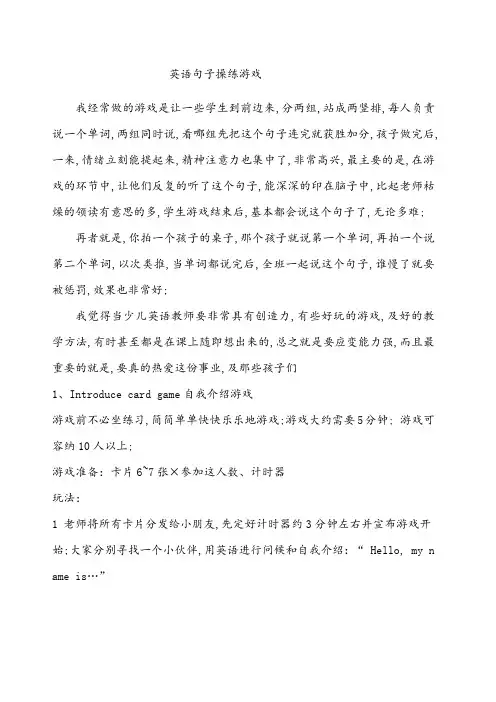
英语句子操练游戏我经常做的游戏是让一些学生到前边来,分两组,站成两竖排,每人负责说一个单词,两组同时说,看哪组先把这个句子连完就获胜加分,孩子做完后,一来,情绪立刻能提起来,精神注意力也集中了,非常高兴,最主要的是,在游戏的环节中,让他们反复的听了这个句子,能深深的印在脑子中,比起老师枯燥的领读有意思的多,学生游戏结束后,基本都会说这个句子了,无论多难;再者就是,你拍一个孩子的桌子,那个孩子就说第一个单词,再拍一个说第二个单词,以次类推,当单词都说完后,全班一起说这个句子,谁慢了就要被惩罚,效果也非常好;我觉得当少儿英语教师要非常具有创造力,有些好玩的游戏,及好的教学方法,有时甚至都是在课上随即想出来的,总之就是要应变能力强,而且最重要的就是,要真的热爱这份事业,及那些孩子们1、Introduce card game自我介绍游戏游戏前不必坐练习,简简单单快快乐乐地游戏;游戏大约需要5分钟; 游戏可容纳10人以上;游戏准备:卡片6~7张×参加这人数、计时器玩法:1 老师将所有卡片分发给小朋友,先定好计时器约3分钟左右并宣布游戏开始;大家分别寻找一个小伙伴,用英语进行问候和自我介绍:“ Hello, my n ame is…”2 然后,猜拳石头、剪刀、布,输的一方给赢的一方一张卡片,再各自寻找新的伙伴,问候、自我介绍、猜拳;手中没有卡片的就坐回原地;计时器响起时,游戏结束;这时手中持有卡片最多的小朋友就是游戏的冠军;建议:这个游戏也可以用于其他游戏主题,适合于巩固练习相关的单词和句型;2、Meet friends game找朋友游戏游戏前不必坐练习,简简单单快快乐乐地游戏; 游戏大约需要20分钟; 游戏可容纳10人以上;游戏准备:快乐的音乐玩法:1 小朋友分成两组,站成里外两个圈;听到老师放音乐后,开始向前走;外圈的人向右走,里圈的人向左走;2 老师将音乐停下后,小朋友们也停下来,并用英语问候站在自己前面的小伙伴,自我介绍;3 反复进行五六次后,老师说:“ Meet your second friend”大家散开去找自己要问候的新朋友;找到后说:“ Long time no see.”然后就坐下来;在老师数到10秒以内找到朋友就算赢,没有找到的就算输;建议:最好多变一些花样,例如加上“How do you do”、“Say hello”等问候语,增加一些难度活跃气氛;3、Friend’s name game小朋友的名字游戏游戏前不必坐练习,简简单单快快乐乐地游戏;游戏大约需要10分钟; 游戏可容纳6人以上;游戏准备:球1个玩法:1 小朋友们站成一个圈,确定好由谁开始后,小朋友拿着球并对大家说:“ M y name is…”然后将球抛给另外一个人;2 接到球的小朋友需要说出抛球人的名字和自己的名字,然后再将球抛给其他人;抛球人是男孩子就要说:“His name is…”是女孩子就要说“Her na me is…”3 游戏继续进行;未说出或说错的小朋友罚出圈外;最后剩下的小朋友就是冠军;建议:熟练之后,在自我介绍的前后加基本的问候语,可以使大家更加兴奋;例如,先说“Hello, his name is Tim. My name is Jane. Good bye.”然后将球抛给别人;说的话多了,游戏才有紧张感;4、Working game职业游戏游戏前不必坐练习,简简单单快快乐乐地游戏;游戏大约需要10分钟; 游戏可容纳10人以上;游戏准备:职业卡片职业种类是参加人数的一半每种2张玩法:1 每人一张卡片;不要让别人看自己的卡片;在老师巡捕开始后,各自找一位伙伴;先用英语问候“Hello, my name is…”然后按卡片上写的讲:“I am nurse.”介绍自己的职业;2 如果对方和自己不是一样的职业,就说“Good bye.”并分开;继续寻找和自己一样职业的人,最先找到的两人胜利;建议:在熟悉游戏以后,在游戏中可以加入一些问候语:“How are you”“I am happy.”“I am five.”等等;游戏也可以用于其他的主题活动,如单词等;5、Bomb game炸弹游戏游戏前需要进行字母及单词游戏的练习方可顺利进行游戏; 游戏大约需要1 0分钟;游戏可容纳6人以上;游戏准备:球1个玩法:1 小朋友先一起记住happy, sad, scared, surprise, angry等表达方式;2 大家站成一个圈,现开始的小朋友拿着球;老师设定计时器2分钟左右宣布开始;3 先开始的小朋友要面带表情地说:“I am happy.”然后将球抛给另一人;接到球的小朋友不能说和前面人不一样的话;计时器响时,拿球的小朋友退出圈外;建议:熟练之后,增加hungry, tired, sleepy等更多的表情是可提高兴趣;另外老师也可以加入到圈中,接球后带表情说英语;大家看到后就会模仿;6、A tall handsome man找伙伴游戏需要记住一些单词方可顺利进行游戏;游戏大约需要20分钟;游戏可容纳6人以上;游戏准备:有人物画或照片的卡片,每种两张,20种左右玩法:1 两个小朋友结成一组,在下面的游戏中一个为提问者,另一个为回答者;老师将两套卡片中的一套分给提问小朋友每人一张;卡片不能给回答小朋友看到,另一套卡片面朝上摆在地板上、摊开;2 老师定好计时器1分钟左右后宣布开始;提问小朋友家乡为某张卡片上的人,使用not给以提示,如“I am not girl.”回答则要找出他说的是哪张卡片;3 ; 回答的小朋友从地板上找出认为符合要求的卡片;如果二人的卡片一样,就得一分;在规定的时间内没有找到同样卡片的一组退出;提示人和回答人要交换位置,继续进行;得分最要的一组获胜;建议:游戏可以以其他的主题内容进行,如:水果这一主题,我们可以让幼儿巩固练习颜色,“It is red.”等等;7、English card game英语卡片游戏游戏前需要进行字母及单词游戏的练习方可顺利进行; 游戏大约需要20分钟;游戏可容纳5人以上;游戏准备:单词卡片用英语、汉语写出日常用品名30张图片卡片用画面表示的日常用品30张玩法:1 大家围坐一圈,选出一个小朋友为小头目;小头目按顺序翻卡片,并按卡片上面写的念“That is a book.”等等;2 大家一起话找画有这个单词的卡片,找到的就说:“This is the book.”并立即将卡片挑出来;挑出卡片的人得到这张卡片;游戏继续进行,直到卡片挑光后,手中卡片多的小朋友就是冠军;8、Is this yours找物主游戏前需要进行字母及单词游戏的练习方可顺利进行; 游戏大约需要10分钟; 游戏可容纳6人以上;游戏准备:参加游戏的小朋友每人三样东西:纸一人一张,铅笔一人一只箱子一个;玩法:1 老师先将每个小朋友的三件东西放入箱子里;混合后再发给每人三样;2 老师宣布爱是后,小朋友开始寻找自己东西的主人;走到别的小朋友面前问:“Is this yours”对方则回答“Yes”或“No”;弄清东西是谁的之后,用英语谢谢东西的名字、在下面写上主人的名字;三样东西的主人弄清楚之后,回到座位上;最先回到座位的小朋友就是冠军;建议:在游戏中,需要小朋友把找的物品的主人写下来;对于幼儿园的孩子来说比较困难,可以请小朋友把物品的主人记在脑海里,最后集中后,老师检查是否正确;9、Is this a nose英语福娃娃游戏前需要进行字母及单词游戏的练习方可顺利进行; 游戏大约需要20分钟;游戏可容纳8人以上;游戏准备:绘画用纸用于画脸的五官一队一份;磁铁用于粘贴眉毛、眼睛、鼻子、耳朵、嘴巴一对一份;手绢用于蒙住眼睛一队一份;盒子用于装脸部各个部位玩法:1 每4、5人分成一小队,在绘画纸上画出脸的五官,剪下来,背后岸上磁铁;老师在黑板上画出人脸的形状,脖子和头发,有多少个队就画多少幅;2 每队选佚名小队长,小队长用手绢蒙住眼睛,从箱子种取出一张画好的五官,问:“Is this a nose”队员回答“Yes,it is.”或“No, it is not.”直到明白是什么部位为止;3 小队长知道是什么部位后,可以往黑板上人的脸上贴;一旦贴上就不能取下来;如此继续进行,贴得位置最正确的小队获胜;建议:如果相同自己队的小朋友开个玩笑,使之将鼻子等贴在黑板上不正确的位置时,可以用英语说“Up”“Down”也可以说“Left”“Right”; 10、Do you like me你喜欢我吗游戏前不必坐练习,简简单单快快乐乐地游戏; 游戏大约需要5分钟; 游戏可容纳8人以上;游戏准备:卡片包括一张画有一颗心的每人一张玩法:1 先选出两名挑战者;老师给其他小朋友每人发一张卡片;拿到画有心的小朋友告诉别人;两名挑战者认为谁拿了画有心的卡片就问哪个小朋友“Do yo u like me”2 被问到的小朋友,如果手中的卡片没有画心,就回答“No”如果手中的卡片画有心就回答“Yes, I like you.”哪位挑战者先找到拿有画有心的卡片的小朋友则获胜;11、Seat game换座位游戏游戏前不必坐练习,简简单单快快乐乐地游戏; 游戏大约需要20分钟; 游戏可容纳10人以上;游戏准备:椅子比参加人数少一把玩法:1 确定一位小朋友扮演魔鬼,摆放好椅子;除魔鬼以外的小朋友都坐在椅子上;魔鬼走到某个小朋友的面前问道:“Do you like this seat”如果这个小朋友回答“YES”魔鬼就走到其他小朋友的面前再问同样的问题;2 如果被问的小朋友回答:“I like Henry and Chris’s seat.”那么除了他们两个人外,其他人都要离开自己的座位,注意不能换左右两边邻近的座位而要去坐别人的座位;这时,魔鬼也要找一个座位坐下;3 如果被问的小朋友回答:“NO”那么所有的小朋友都要换座位;这时,魔鬼也要找一个位置坐下,没有位置的小朋友当魔鬼;建议:如果魔鬼突然向小朋友问一句别人的座位,如“Do you like Tom’s seat”是不是很有趣呢被问的小朋友一回答“yes”那么除了Tom以外的所有人都得换座位;大家都没有心理准备,一定会吓一跳;12、Belonging game猜东西游戏需要记住一些单词方可顺利进行游戏; 游戏大约需要10分钟; 游戏可容纳8人以上;玩法:1 每4~5人分成一队,排成一列;各小队选一名小头目;老师宣布开始后,小头目运用“Do you have…”凭自己的想象开始询问队员手中各有什么东西;2 如果回答“YES”接着问下一名队员;这时再提问的东西不能重复前面问过的;如果回答“NO”就换一样东西问,直到对方回答“YES”为止;最先问完,全队人员都回答“YES”的队胜利;13、Hunt the ring找戒指游戏游戏前不必坐练习,简简单单快快乐乐地游戏; 游戏大约需要10分钟; 游戏可容纳8人以上;游戏准备:玩具戒指一个玩法:1 分成两小队,每队各选一个头目;两队面对面各站成一排;然后确定功放和守方;守方队员都将自己手背再身后,听到老师宣布开始后,从第一个人开始传递戒指;注意不要让对方的队员看到戒指在谁的手中;2 老师命令停止时,守方队员停止传递戒指;并一起说:“I have the ring.”装出有戒指的样子;3 功放队员一起猜戒指究竟在谁的手中;决定好以后,小头目走到这个小朋友面前问道:“Do you have the ring”如果猜对了,就得一分;两队交换攻守,按同样的方法继续进行;五个回合以后,得分多的队胜利;建议:除了戒指,也可以选握在手中看不见的其他东西;14、Go Go Ball game球的游戏游戏前不必坐练习,简简单单快快乐乐地游戏;游戏大约需要10分钟; 游戏可容纳5人以上;游戏准备:球1个玩法:1 小朋友站成一圈,其中一个人拿球;拿球的人在“I am going to…”的后面加上自己喜欢的地方,说完后将球抛给别的小朋友;2 接到球的小朋友回答说自己喜欢去的地方;如“I am going to the par k.”说完后再将球抛给其他人;回答不出来或重复前面小朋友已经说过的地方时要退出圈外;最后剩下的那个人就是冠军;15、Shadow picture game投影游戏需要记住一些单词方可顺利进行游戏; 游戏大约需要30分钟; 游戏可容纳10人以上;游戏准备:白布单、手电筒、日常用品10件左右玩法:1 分成两队,确定先攻后攻顺序;后攻小队就像放幻灯片那样,将日常用品的影子投在白布单上;然后一起问:“What is this”2 攻防队员仔细观看投影,一起商量是什么,得出结果后一起回答:“ It isa …”猜对了得一分,攻守交换,五各回合后,得分多的队胜利;16、Drawing game绘画联想游戏需要记住一些单词方可顺利进行游戏; 游戏大约需要5分钟; 游戏可容纳8人以上;游戏准备:卡片游戏使用的单词20张、计时器玩法:1 每4~5人分为1小队,各队按顺序排成1列;老师将卡片给每个小队的第一名小朋友看;2 老师定好计时器5分钟左右并宣布开始;看过卡片的人将卡片上的单词画在黑板上,然后问队员:“What is this”。
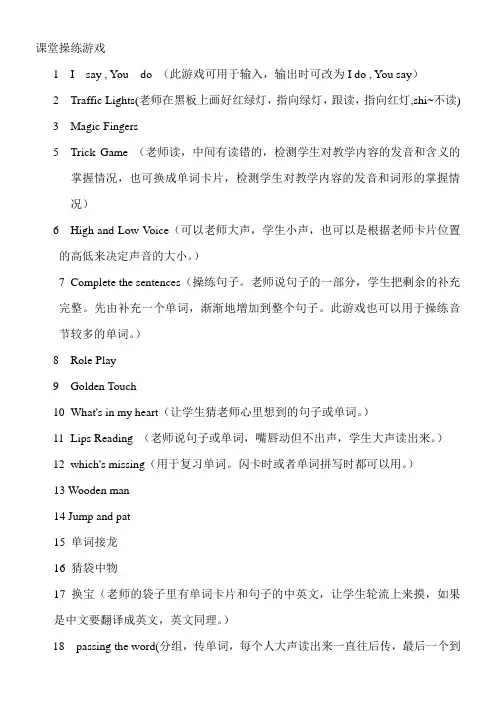
课堂操练游戏1 I say , You do (此游戏可用于输入,输出时可改为I do , You say)2 Traffic Lights(老师在黑板上画好红绿灯,指向绿灯,跟读,指向红灯,shi~不读)3 Magic Fingers5 Trick Game (老师读,中间有读错的,检测学生对教学内容的发音和含义的掌握情况,也可换成单词卡片,检测学生对教学内容的发音和词形的掌握情况)6 High and Low V oice(可以老师大声,学生小声,也可以是根据老师卡片位置的高低来决定声音的大小。
)7 Complete the sentences(操练句子。
老师说句子的一部分,学生把剩余的补充完整。
先由补充一个单词,渐渐地增加到整个句子。
此游戏也可以用于操练音节较多的单词。
)8 Role Play9 Golden Touch10 What's in my heart(让学生猜老师心里想到的句子或单词。
)11 Lips Reading (老师说句子或单词,嘴唇动但不出声,学生大声读出来。
)12 which's missing(用于复习单词。
闪卡时或者单词拼写时都可以用。
)13 Wooden man14 Jump and pat15 单词接龙16 猜袋中物17 换宝(老师的袋子里有单词卡片和句子的中英文,让学生轮流上来摸,如果是中文要翻译成英文,英文同理。
)18 passing the word(分组,传单词,每个人大声读出来一直往后传,最后一个到黑板上写出来。
)19 happy fax.(老师轻声告诉每组的第一个学生一个单词或句子,他们再轻声传给他前面的人,最后一个人大声说出来,比速度和准确率。
)20 catching game21 point and say (可以单独操练一个单词,也可以是操练整个句子。
操练整个句子时每个学生说一个单词。
)22 The wolf is coming23 Let’s count off(把报数字改为句子或单词)24 Follow me(老师以不同的声调来读句子,学生模仿。

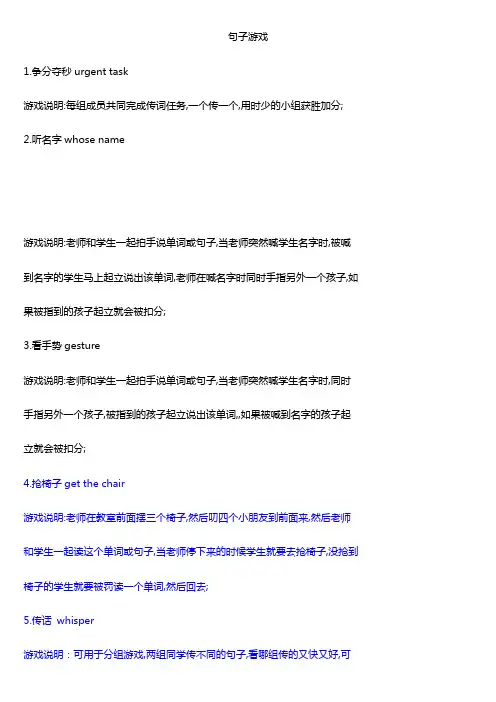
句子游戏1.争分夺秒urgent task游戏说明:每组成员共同完成传词任务,一个传一个,用时少的小组获胜加分;2.听名字whose name游戏说明:老师和学生一起拍手说单词或句子,当老师突然喊学生名字时,被喊到名字的学生马上起立说出该单词,老师在喊名字时同时手指另外一个孩子,如果被指到的孩子起立就会被扣分;3.看手势gesture游戏说明:老师和学生一起拍手说单词或句子,当老师突然喊学生名字时,同时手指另外一个孩子,被指到的孩子起立说出该单词,,如果被喊到名字的孩子起立就会被扣分;4.抢椅子get the chair游戏说明:老师在教室前面摆三个椅子,然后叨四个小朋友到前面来,然后老师和学生一起读这个单词或句子,当老师停下来的时候学生就要去抢椅子,没抢到椅子的学生就要被罚读一个单词,然后回去;5.传话whisper游戏说明:可用于分组游戏,两组同学传不同的句子,看哪组传的又快又好,可以进行奖励;6.老狼,老狼,几点了Wolf wolf what’s the time游戏说明:可用于不数字或时间相关的知识操练,大家围成一圈一起问“wolf wolf what’s the time”当说到约定的时间时所有同学跑向自己的座位或指定的安全区,被抓住的学生要进行扣分或表演节目的处罚;7.邮递员postman游戏说明:准备两套可拼成句子的单词卡,每组选派两名同学成为邮递员,老师把两套卡打乱;看哪组能最先拼出完整的句子,就像邮递员要把每封信正确的送到每一家一样,其余学生在下面说句子,此游戏适合句子操练;8.时间的学习what time is it游戏说明:请12名幼儿分演12个钟点,胸前帖上数字卡片,围站成一圈;游戏开始,大家一起说:“what’s the time What’s the time”老师突然指向一个小朋友,大家根据数字回答"It's One……"同时蹲下,只有被指到的小朋友站着;9.串项链necklace游戏说明:适于操练句子将句中单个名词串成项链最后戴到脖子上;10.火眼金睛eyes and ears游戏说明:适合复习环节使用,即教师只摆口型,不出声音;学生要根据老师的口型猜单词或句子;11.接力赛relay race游戏说明:分两组到前面站好然后最后一位同学说句子也可说单词说完之后跑到最前面,后面接着说哪组最快又最准确的完成就算胜利;。
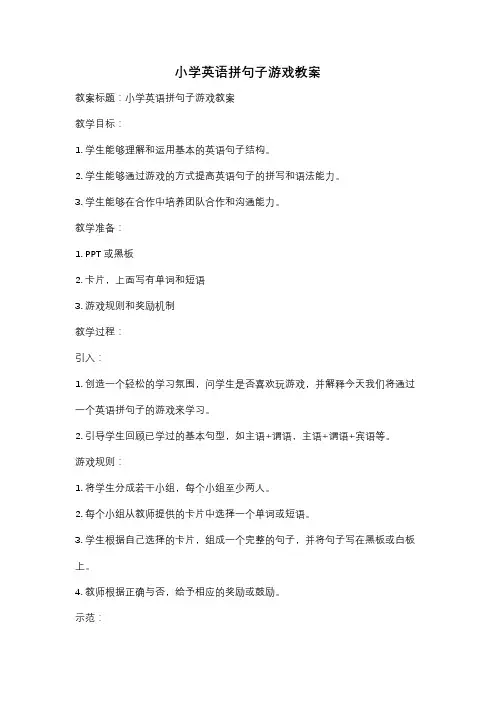
小学英语拼句子游戏教案教案标题:小学英语拼句子游戏教案教学目标:1. 学生能够理解和运用基本的英语句子结构。
2. 学生能够通过游戏的方式提高英语句子的拼写和语法能力。
3. 学生能够在合作中培养团队合作和沟通能力。
教学准备:1. PPT或黑板2. 卡片,上面写有单词和短语3. 游戏规则和奖励机制教学过程:引入:1. 创造一个轻松的学习氛围,问学生是否喜欢玩游戏,并解释今天我们将通过一个英语拼句子的游戏来学习。
2. 引导学生回顾已学过的基本句型,如主语+谓语,主语+谓语+宾语等。
游戏规则:1. 将学生分成若干小组,每个小组至少两人。
2. 每个小组从教师提供的卡片中选择一个单词或短语。
3. 学生根据自己选择的卡片,组成一个完整的句子,并将句子写在黑板或白板上。
4. 教师根据正确与否,给予相应的奖励或鼓励。
示范:1. 教师先示范一个例子,选择一个卡片上的单词或短语,然后将其放在黑板上。
2. 教师解释自己选择的单词或短语,并将其与其他学生共同组成一个句子。
游戏进行:1. 学生分组进行游戏,每个小组选择一个卡片上的单词或短语,并组成一个句子。
2. 学生将句子写在黑板上,并等待教师的检查。
检查与讨论:1. 教师检查每个小组写在黑板上的句子,并给予正确与否的反馈。
2. 教师与学生一起讨论每个句子的正确性和改进的方法。
游戏进阶:1. 增加游戏难度,要求学生使用更复杂的句子结构,如条件句、比较句等。
2. 增加游戏时间限制,鼓励学生在有限的时间内完成句子的拼写和组合。
总结:1. 教师总结游戏中学生的表现,并强调学生在游戏中提高英语句子的能力。
2. 教师鼓励学生继续通过游戏的方式学习英语,并提供其他相关的游戏或练习资源。
拓展活动:1. 学生可以在小组之间进行竞赛,看哪个小组能够用最多的卡片组成正确的句子。
2. 学生可以将自己写的句子进行口头表达,提高口语能力。
评估方式:1. 观察学生在游戏中的参与程度和表现。
2. 检查学生写在黑板上的句子的正确性和语法准确性。
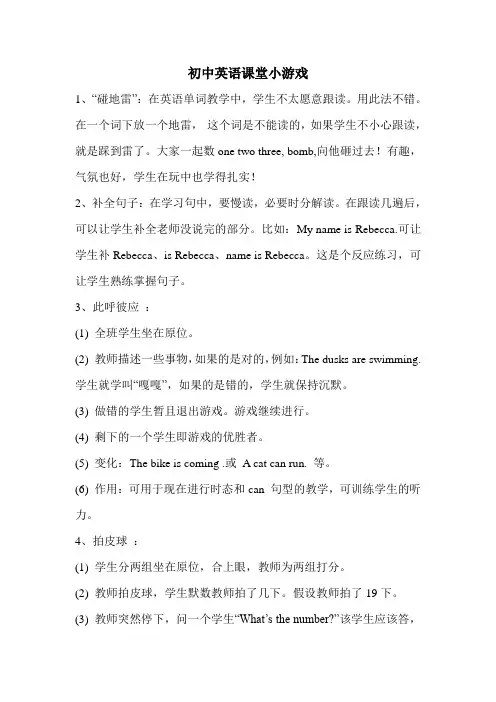
初中英语课堂小游戏1、“碰地雷”:在英语单词教学中,学生不太愿意跟读。
用此法不错。
在一个词下放一个地雷,这个词是不能读的,如果学生不小心跟读,就是踩到雷了。
大家一起数one two three, bomb,向他砸过去!有趣,气氛也好,学生在玩中也学得扎实!2、补全句子:在学习句中,要慢读,必要时分解读。
在跟读几遍后,可以让学生补全老师没说完的部分。
比如:My name is Rebecca.可让学生补Rebecca、is Rebecca、name is Rebecca。
这是个反应练习,可让学生熟练掌握句子。
3、此呼彼应:(1) 全班学生坐在原位。
(2) 教师描述一些事物,如果的是对的,例如:The dusks are swimming.学生就学叫“嘎嘎”,如果的是错的,学生就保持沉默。
(3) 做错的学生暂且退出游戏。
游戏继续进行。
(4) 剩下的一个学生即游戏的优胜者。
(5) 变化:The bike is coming .或A cat can run. 等。
(6) 作用:可用于现在进行时态和can 句型的教学,可训练学生的听力。
4、拍皮球:(1) 学生分两组坐在原位,合上眼,教师为两组打分。
(2) 教师拍皮球,学生默数教师拍了几下。
假设教师拍了19下。
(3) 教师突然停下,问一个学生“What’s the number?”该学生应该答,“Nineteen”。
如果他答对了,该组得分,并由该学生接替教师拍球,游戏继续进行,如果他讲错了,就让别的学生纠正。
(4) 哪组学生得分多,就为胜者。
(5) 变化:教师拍球时可以在中间来个停顿。
如先拍4下,停一停,再拍3下,接着问:“What’s the number?”学生应答“Seven”“Four plus three is seven.”(6) 作用:操练数词和加法运算句型。
5、将错就错:(1) 学生坐在原位,注视着教师。
教师在教室里随意走动,他可以突然停在一个学生面前,用手指着自己的鼻子说:This is my eyes(有意讲错) 那个学生也将错就错,指着自己的眼睛说:This is my nose.(2) 如果学生讲错了,就让他代替教师,再同样地做一遍。

快乐传真游戏的目的:通过趣味性的活动,激发学生对于英语的兴趣游戏的准备:良好的输入,最好教师能设计一部分动作游戏的具体操作:其实这个游戏和前一个游戏差不多,但是何谓快乐传真?我想等我举个例子后大家就明白了!教师先出示一些图形和单词卡片,先带读,这个是每个单词游戏的准备阶段,为大家有一个好的热身,完成这个起步阶段,同时淡化我们的教学环节转化。
然后教师要求两个学生到前面来,一个同学面对老师,另一个背对老师,老师先把单词或者图片给面对老师的那个同学看,然后让他设计一个动作出来,让背对老师的那个同学猜,背对的那个同学如果猜对,表扬!而其他的同学做什么呢?老师在面向老师的那个同学设计游戏的时候,教师可以把单词或者卡片展示给其他同学看,让别的同学也帮忙设计。
当然也可以不展示给别的同学看,防止那个同学回答不出来我们请帮手。
这个游戏可以说趣味性很强,培养了学生的创造能力,记得我以前在广东用这个方法教幼儿园的时候,其反应特别好,很多学生自己设计了动作后回家让父母猜。
注意事项:(1)这个游戏在操作的时候,很容易忽视没有参加游戏的同学,我们在操作的时候,也要求那些没有参加游戏的同学动起脑子来,让他们时刻准备帮助上面的同学。
(2)有些同学设计的动作很简单,但是猜的同学不能猜,那么就会有同学很激动,这个时候教师就要注意培养学生良好的学习行为习惯了。
快乐传真目的练习He\ She is doing 道具相关单词图片,如踢足球、做早操、游泳、骑自行车、照相、看电视等。
方法将学生分为两组轮流比赛。
老师从图片中任意选一张,纸出示给学生A1和B组看。
A1根据图片上的内容,用动作表演的形式把图片信息传递给A组其他同学。
A组同学用He \ She is doing 说出A1的表演内容,说对即得一分。
AB组轮流游戏,那组在单位时间内表演的图片最多,即赢得比赛。
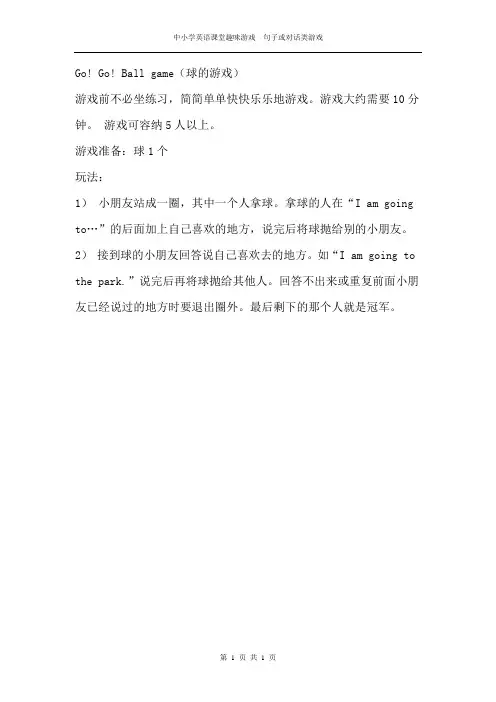
中小学英语课堂趣味游戏句子或对话类游戏
Go! Go! Ball game(球的游戏)
游戏前不必坐练习,简简单单快快乐乐地游戏。
游戏大约需要10分钟。
游戏可容纳5人以上。
游戏准备:球1个
玩法:
1)小朋友站成一圈,其中一个人拿球。
拿球的人在“I am going to…”的后面加上自己喜欢的地方,说完后将球抛给别的小朋友。
2)接到球的小朋友回答说自己喜欢去的地方。
如“I am going to the park.”说完后再将球抛给其他人。
回答不出来或重复前面小朋友已经说过的地方时要退出圈外。
最后剩下的那个人就是冠军。
第1 页共1 页。
教案【篇一教学中用的】 1、“碰地雷 ”:教学中,学生不太愿。
用此。
在下放一个地是的,如果学生不小, 就是踩到雷了。
大家一起数 one two three,bomb, 向他砸过去!有 趣,气氛也好,学生在玩中也学得扎实! 3、、此呼彼应:( 1) 全班学生坐在原位。
(2) 教师描述一些事 物,如果的是对的,例如: the dusks are swimming. 学生就学叫 “嘎嘎 ”,如果的是错的,学生就保持沉默。
(3) 做错的学生暂且退出 游戏。
游 行。
(4) 剩下的一个生胜者。
(5)变化: the bike is coming . 或 a cat can run. 等。
(6) 作用:可用于现在进行 时态和 can 句型的教学,可训练学生的听力。
4、拍皮球 :(1) 学生坐在原位,合上眼打分。
(2)拍皮球,学生默拍了几下拍了 19 下。
(3) 突然停一个学: “w h a t ’s t h e n u m b e r “n i n e t e e n ”如果组得分,学生接拍球, 进行,如错了别的正。
(4)学生得 分多胜者。
(化可以来。
如先 拍 4 下,停一停,再拍 3 下,: “what ’s the number? ”学生 “seven ”或“f our plus three is seve n. ” (6)作用:操练数词和加法运算句型。
5、加减连算 :(1) 学生分成两组,互相出题,教师仲裁打分 (2) 由 a 组第一个学生先出题,如: five plus five ⋯ ⋯组b 第二个学生必 须立即回答: five plus five is ten. 然后由该生再接下去,如: minus four, a 组第二个学生再接着答题t en minus four is six. 如果 组就扣分。
(3) 数字的和或差5+5- 4+8⋯ ⋯ (5) 作6:(1) 学生坐在原位。
Alphabet Shout OutRandomly choose an alphabet flashcard and award a point to the first student who shouts out a word beginning with that letter.Alphabet Writing RelayDivide and line up the students into two teams. Divide the board into two halves and have one student from each team run to the board, write 'A', then run to the back of the line. The next student writes 'B', etc. The first team to finish wins. Alphabet Erase relayAs 'Alphabet Writing Relay', but this time, write the alphabet on each half of the board and have each team race to erase the letters in order.Alphabet SculpturesDivide the students into teams and call out a letter of the alphabet. Award a point to the first team that can form the letter with their bodies.Alphabet SoupGive each student an alphabet flashcard and have them skip around the room to the 'ABC Song'. Stop the tape at random and have the students rush to line up in order, e.g. A-K.Alphabet TouchCall out letters and have the students find and touch them in the classroom, on posters, etc.Alphabet WaveGive each student a few ordered alphabet flashcards and play the 'ABC Song'. Have the students hold up the cards that correspond to the letters they hear in the song.Animal CrackersTake a big dice and assign an animal to each number. Have the students roll the dice and act like the animal!The BallThrow the ball to a student and ask that student a question. The student answers and throws the ball to another student asking the same question. E.g. "Can you...?", "Yes, I can. / No, I can't." "Do you like...?", "Yes, I do. / No, I don't." Balloon TossHave the students stand in a circle. Toss a balloon to one student and elicit vocabulary or a structure from that student. They must be able to tap the balloon in the air without missing the vocabulary or structure E.g. S1: "My name's Miki. What's your name?" (tap) "My name's Hiro. What's your name?" (tap).Basic Flashcard FunThe teacher simply holds up a flash card and elicits the answer from the students. This can be done in teams with points awarded for correct answers.Beat The ClockTime the students as they race to put alphabet, days of the week, or month flashcards in order. Have them try again to see if they can beat their fastest time.BingoBingo can be used with any topic. Blank Bingo sheets can be used, and students can write of draw randomly in the boxes. The winner is the first student to cross out all the numbers/letters etc. on the sheet.Blindfold ConversationArrange the class in a circle and choose one student to stand in the circle with a blindfold on. Spin the student and tell him/her to point. Tell the student to guess the name of the student he/she is pointing at by talking to him/her. E.g. "Hello. How are you? Do you like...?"BluffThe object of the game is to be the first student to get rid of all his/her cards. Divide the students into small group and deal flashcards to each student. Player 1 chooses a card from his/her hand and throws it face down on the table saying, for example, "I have (a cat)". Player 1 may be telling the truth or bluffing. If player 2 has a 'cat' in his/her hand then there's a good chance player 1 is bluffing. Player 2 should say "No, you don't". If player 1 was bluffing, player 2 gives player 1 a penalty card from his/her hand. If player 1 was telling the truth then he/she gives player 2 a penalty card from his/her hand. Continue until one student is out of cards.The BombPass a ball, object or a flash card around a circle of students. When the timer rings, the student holding the ball must answer a question, make a sentence or say a word.Car RaceArrange the flash cards in a long line with starting and finishing points. Give each student a counter. The first student throws the dice and moves. The student must say the word on the flashcard he/she lands on. If the student makes a mistake, he/she goes back to his/her original place. Add colored paper between cards to represent 'Take Another Turn', and assign a crash number e.g. #4 on the dice which means the student must return to the beginning.Catch The FruitToss a piece of plastic fruit to a student and ask, "What is it?" Elicit and prompt the correct vocabulary. Gesture the student to throw it back to you and repeat with different fruit and students. For a variation see 'The Ball'.CharadesDivide and line up the class into two teams. The first student from each team comes to the front. The teacher whispers a word or shows a flashcard to the two students and they act it out. The first team to call out the correct word gets a point.E.g. sleeping, eating, playing soccer...ClustersPlay any music and have the students walk, skip, jump, hop, etc around the room randomly. Stop the music and call out a number between 1-8. The students must quickly get together in a group or groups of that number, and the odd students must sit out until the next round.CommandoThe teacher is the commando and gives commands to the class and/or individual students. This is a great energy burner as well as review of actions colors, numbers or anything else you can throw in. E.g. "Jump 10 times", "Touch your (body part)", "Touch (classroom object", "Turn around", "Stand up / Sit down".Concentration / MemoryHave the students sit in a circle. Spread out the flashcards (2 sets) face down. Students take turns flipping over two cards and saying the vocabulary. If the flashcards are a match, the student keeps the cards. If they are different, they remain face down. The student with the most pairs is the winner.Conversation RelayLine up the students in two teams and have the last student in each team tap the shoulder of the student in front and have a conversation E.g. "What's you name?", "How are you?". The student answering then starts the same conversation with the student in front, and so on. When the conversation reaches the front, the student at the front must run to the back and continue the procedure. The first team to get all the students back in their original positions wins. Crazy TrainStudents line up behind the teacher in a choo choo train line. Give commands such as "faster", "slower", "turn left", and "stop".Dance Of The OstrichesPair up students and attach a flashcard to their backs. The object of the game is to look at the other student's flash card and yell out the word before they see yours.Draw It RelayDivide the students into two teams. Whisper a flashcard to the first member of both teams and have them run to the board and draw the word as fast as possible. Award points to the fastest team.Duck Duck GooseStudents sit in a circle and the teacher starts by walking round the outside of the circle tapping the students on the head saying "duck". When the teacher says "goose" the student whose head was touched must jump up and chase the teacher round the circle. The teacher must sit down in the student's spot before being tagged. If tagged, the teacher must continue tapping heads. If not, the student walks around the circle touching heads. It might be easier to use vocabulary like "cat, cat, dog" or similar, or even "duck, duck, dog" to practice awareness of 'u' vs 'o' and 'g' vs 'ck' sounds. Fashion ShowHave each student stand up one at a time and elicit from the class what he or she is wearing.Find ItThe teacher holds up a letter flashcard. The students must search around the room to find either a corresponding object/picture that begins with that letter or find that same letter written somewhere in the room. The purpose of this game is letter recognition. It can be played as a relay race with two teams racing to find the letters first.First letterGive the students various picture flashcards. Go through the ABC's and instruct students to hold up the flashcards that begin with that letter.Flash Card Act OutChoose one or more students to come to the front. Show a flash card or whisper a word, and have the students act it out. Reward the first student to guess the correct answer. This can be used with many subjects (e.g. sports, actions, verbs, animals, etc.)Flash Card WalkArrange the flashcards in a big circle. Play some music while the students walk around the circle. When the music stops, call out a flashcard, and the student standing next to the flashcard wins.Follow The LeaderStudents line up behind the teacher and follow the teacher's actions. Use as a review for identifying and chorusing classroom objects or acting out actions. Give the students a chance to lead.GesturesUse western gestures in your class.Expressions GesturesHello waveGoodbye waveIt's cold put arms around shouldersIt's hot fan your face with handsNo! shake your head "no"Come here move your index fingerMe! Touch your chestOK make the OK signI don't know pull shoulders and hands upShhhh index finger in front of mouthStop hand up, palm outStand up raise hand slightly, palm upSit down lower hand slightly, palm downGo FishHave students choose two flashcards each. Have the students hold the flashcards face up but not to show anyone. Choose a student and ask "Do you have a cat?" If the answer is yes, they have to give you the flash card. Have each student ask other students questions. A student with no cards is out.GrabUse Lego. Spread out the Lego and call out "(Five!)". The students should take five blocks, join them together to make a pattern and hold them up. Next say "two blue, one yellow" and other combinations to 5.Grab It Relay / Race to TouchLay the flashcards on the floor at one end of the room, and have the students line up in teams at the other end of the room. Call out a flashcard and have the first person in each team race to grab the card. Those students then go to the back and the next students race to grab the next flashcard the teacher calls.HangmanUse review words from past lessons. The teacher chooses a word and writes the appropriate number of spaces on theboard. Students guess a letter one by one. If the student guesses correctly, write that letter in the space and give the student another turn. If they guess wrongly, start drawing a hanging man and have the next student guess a letter. Let the first student to guess the word take the teacher's place. You may prefer to draw a hanging spider (Spiderman?) instead.Hot PotatoPlay like 'Pass It' using a time limit for added motivation. Set the timer for 10 seconds. When the timer goes off, the student holding the flashcard must say the vocabulary / structure.I SpyThe teacher says "I spy with my little eye something beginning with G". Students try to guess the object (E.g. garbage can). Use classroom objects and with younger students use colors rather than letters e.g. "I spy with my little eye something (red)."I've Got ItHave students sit in a circle. Give each student a flashcard or item. Ask "What is it?" and elicit the vocabulary. Call out the vocabulary and have the students stand up and say the flash card. Repeat until all the students are standing, then continue until all the students are sitting. Go at a fast pace so the students are sitting and standing rapidly.JeopardyMake a jeopardy grid on the white board as follows: JeopardyFruit Sports Animals Body10 _______ _______ _______ _______20 _______ _______ _______ _______30 _______ _______ _______ _______40 _______ _______ _______ _______50 _______ _______ _______ _______In teams, or individually, let the students randomly pick a category and the points to be attempted. The teacher will then ask a question and (a 40 point question should be more difficult than a 10 point question) if the students get the correct answer their team name is written in that box. When all the boxes are filled the team with the most points wins. Jumping The LinePut a piece of tape across the middle of the floor or draw an imaginary line dividing the room. Designate ones side as 'true' and the other side as 'false'. Line up the students on the line, hold up a flashcard and say a word. If the students think you said the word that matches the flashcard, they should jump to the 'true' side, otherwise they should jump to the 'false' side. Students who make a mistake should sit out until the next round.LegoSpread Lego on the floor and call a color for the students to pick up. Continue until all the colors have been called. Allow the students to play with the blocks for a few minutes before packing up. While the students are playing, talk to them about what they're making and the colors they're using.Letter To Word MatchGive each student an alphabet flashcard, and spread alphabet picture cards randomly around the room. Play and sing the 'ABC Song'. When finished, have the students match their alphabet card to an alphabet picture card and say the letter and vocabulary. Change cards and repeat.Listen and OrderPut the students into pairs and give them number cards (1-10). Call out numbers (out of order) and have the students put their cards in that order. When finished, have the students chant the numbers in the order you gave themMagic FingerPrint a letter of the alphabet on the board. Instruct the students to stand and face the board. Raise your 'magic finger' and trace the letter in the air. Be silly and use other parts of your body to trace the letter, e.g. elbow, foot, nose, tongue. Make A SentencePut the students into teams and lay out a selection of flashcards or items. One student from each team chooses avocabulary item and uses it correctly in a sentence. Give each student ten seconds on the timer. Reduce the time in the second and third round. As the item is named, the teacher puts it away and gives the team a point. Write the points on the whiteboard.Map GameUse a world map and elicit "Where are you from?", "Where do you live?", "Where do people speak Spanish?", "Where's China?", and any other questions you can think of. Also show and tell the students about where you are from. Memory BuzzHave the students sit in a circle and start building a sentence. Student 1 says "In the classroom, I see a clock", student 2 says "In the classroom, I see a clock and a map", student 3 says "In the classroom I see a clock, a map and a chair" etc. For a variation, see 'Question Chain'.Memory MasterHave the students sit in a circle. Designate one student to be the Memory Master. Arrange the flashcards face up in the center. Each student chooses a flashcard and says the word. They cannot touch the flashcards. After everyone has chosen, the Memory Master must hand the correct flash cards to each student.Memory TrayBring in a tray of various review or new objects. Elicit the names of the objects and give the students a minute to memorize what's on the tray. Take the tray away and see how many objects can be remembered. Older students should write a list of objects. The student who remembers the most objects gets a point. Can be done with flashcards. Musical ChairsLine up the chairs and place a flashcard on each one. Play some music and have the students walk, skip, jump around the chairs. When the music stops, the students should sit down on a chair and shout out their flash cards. For more excitement remove a chair while the music is playing and make the chair-less student sit out until the next round. Object TossSelect three soft objects. Assign object#1 the question "Do you want some milk?", assign object#2 the response "Yes, I do." And object#3, "No, I don't". Toss each object to a student and have them use the appropriate phrase. Then they toss the objects to different students.On My BackLine up the students in two teams and have them face the front. Show an alphabet flashcard to the student at the back of each line and have them use their finger to draw the letter on the back of the student in front. The next student draws on the next student and so on. The student at the front of each line then writes the letter on the board.Paper Airplane ContestGive students a couple of minutes to make an airplane and one minute to test them. Divide the students into two teams and have the teams stand at the back of the room. Ask a student a question and if the answer is correct that student gets a throw. Assign points to different objects in the room (white board = 10pts., far wall = 15pts., etc.). Each student should be asked a question and teammates can help if needed.Pass ItHave the students sit in a circle. The teacher holds up a flashcard or object (e.g. ball, pen, eraser, etc.), says the word and passes it to the next student. That student holds up the card/object and says the vocabulary and passes it on. After a couple of rounds start the flash cards/objects going in the opposite direction. Also try a speed round.Pass The SecretHave the students sit in a circle. Show them that they have to whisper to the person next to them. Start the secret by whispering it to the student next to you, e.g. "It's Windy." Have the students pass the secret around the circle. The last student says the secret out loud. Compare how close it is to the original secret. If necessary, write the original secret on the board.PictionaryHave a student come up to the front and show him/her a flashcard. That student should draw it on the board. The first student to guess the picture gets a point. This can also be played in teams.Question ChainHave the students sit in a circle. The teachers starts by asking the student on the right a question. That student mustanswer the question and ask the next student the same question. Go round the class then change the question. For a variation, see 'The Bomb'.Quick PeekCover a flashcard and quickly show it so the students get just a quick peek. Reward the student who can guess it correctly.Run And Get ItDivide the class into two teams and have them stand in two lines facing each other. Assign each team member a number from one to four. Place a few flashcards in the middle of the two teams. Call a number and a flashcard, e.g. "Student three - rabbit". The students assigned that number must run into the center and touch the flashcard and shout "rabbit". The member who touched and called first can take the flashcard to their side.ScrabbleWrite a selection of letters on the board. Explain to the students that they have to make up as many words as possible from the given letters. Model one or two examples on the board for them. Give them a time limit.Ship In The FogMake an obstacle course, put a blindfold on a student and have the other students verbally help him or her through the course. For example: Take 2 steps, turn left, one small step, etc.Shiri ToriThis is a popular Japanese game. Have everyone sit in a circle. The teacher says a word and each student must add a word that begins with the last letter of the word just spoken e.g. apple-egg-girl-lion-neck-etc.Shoot The BasketThis can be done in teams or individually. Ask a student a question and if the student answers correctly then he/she gets a shot at the basket. Variations include rolling a ball between 'posts', throwing a ball to knock a stuffed animal off a box, bouncing a ball into a bucket, etc. Award points.ShoppingUse plastic fruits, vegetables or corresponding flashcards. Gather the students around you and let them ask for what they want using a dialog such as: "What do you you want?", "An apple, please.", "Here you are.", "Thank you.", "You're welcome." Then the teacher calls back the objects from the students, "Apple, please". Then the students put the fruit back into the basket.Simon SaysPlay Simon Says as a review using "touch" body parts, classroom objects, etc., or with actions. E.g. "Simon says touch your toes" = Students touch their toes. "Touch your eyes" = Students don't move. When a student makes a mistake, he/she must sit out until the next round.SlamHave the students sit in a circle with their hands on their heads. Spread the flashcards face up in the middle. The teacher calls out a flash card and the students race to touch it. The first student to touch it gets to keep the flashcard. In the case of a tie, have the students 'Rock, Scissors, Paper'.Slow MotionPut a flashcard in a bag or behind something. Pull it out very slowly showing only the top part of the picture at a time. Reward the first student who can guess it correctly.Spelling BeeThis can be done with the whole class or in two teams. The first player on team one is given a word to spell orally. The teacher writes the letters on the board as they are spelled out loud. If correct, the team gets a point. If you do a class competition, line the students up and give them words one by one. When they make a mistake they must sit down. The last student standing is the winner.Spelling GamePut a name or word on the board and have teams or individuals make as many words as possible from those letters, e.g. Brad Pitt = bat, rat, bad, at, etc.Spin The BottleUse the bottle to ask each student questions. The teacher spins the bottle and asks the student it points to a question. First ask basic warm-up questions and then move on to target structures or review structures.TenStudents stand in a circle and chorus counting from 1-10. Instruct the students to each call out one, two or three of the numbers in numerical order. The student who calls out 'ten' must sit down. Continue until only one student is standing. That student wins the game. E.g. "one, two", "three, four, five", "six", "seven, eight, nine", "ten (sits down)", "one"..... Try playing it backwards as an extra challenge.Tongue TwistersUse these tongue twisters with older students. They work well as an extension activity.1) She sells seashells by the seashore.2) Rubber baby buggy bumpers.3) Peter Piper picked a peck of pickled peppers.4) How much wood would a woodchuck chuck if a woodchuck could chuck wood?Topic TagGive a topic, e.g. fruit. The students must run around the room trying to avoid the teacher's tag. If the student is tagged, he/she has five seconds to name a fruit. If no fruit can be named or the fruit has already been said, that student should sit out until the next round.TouchOrder the students to touch various objects around the classroom e.g. "Touch your book", "Touch something red". Vocab with Rock, Scissors, PaperLay the flashcards in a straight line on the floor. Assign two teams and have them line up at each end of the flashcard line. When you say 'Go' the first member from each team starts to walk from their end of the line, straddling the flashcards, reading the vocabulary out loud as they walk. When the two students meet they have to Rock, Scissors, Paper, the losing student goes to the back of his/her line and the winning student continues along the flashcard line. The second student from the losing team starts walking and reading the vocabulary until the two students meet and Rock, Scissors, Paper, and so on. Give points for reaching the opposite end of the line.What's Missing?Scatter 8-10 flashcards face up on the table. Give the students a minute to look at them, then have them close their eyes and take away one flashcard. Tell the students to open their eyes and ask, "What's missing?". Reward the student that guesses correctly.What Time Is It, Mr. Wolf?Have the students line up against the back wall. The teacher should stand with his/her back turned to the class. The students must ask the teacher "What time is it, Mr. Wolf (or teacher's name if easier)?". The teacher answers with a random time, e.g. "It's four o'clock" - the students take four steps toward the teacher. The students should move the corresponding number of steps. If the teacher says "It's lunch time!", the students must run to safety at the back wall. The teacher chases the students and if tagged, the student must sit out until the next round.Who's Got What?Have the students sit in a circle and secretly pass a few objects or flashcards from hand to hand under the table or behind their backs. Say, "Stop", and ask "Who has the (apple)?" The students should point to who they think has the (apple) and say "He/She does." The first student to guess correctly should be rewarded.Winner Says MA variation on the activity 'Ten'. Write a big 'M' on the board and have the students take turns reciting the alphabet, saying one or two letters each. The student who says "M" is the winner. E.g. "A", "BC", "DE", "F", "G", "HI", "J", "KL", "M" (winner)! Variations: Numbers 1-21 (winner says 21), Days of the week (winner says Sunday), Months of the year (winner says December).。
教学分享
主题:课堂上句子教学的游戏;
1.你做我猜(You do, I guess);某些句型可以配合动作,让小朋友去做动作,另外
的小朋友去猜是什么动作,用语操练句型例如:I can swim….
2.拯救公主(Save the princess); 游戏说明:在黑板上画一个牢房的四方格,老师
问学生问题,用语操练句型,学生对一个就少一个格子,直到救出公主;
3.过山车(get on the train) :游戏说明:学生们手拉手围成圈边走边说要操练
的句子或单词,老师和一个圈里的学生手撑手扣住哪个学生,学生需说出所操练的句子;
4.抢椅子(get the chair) :游戏说明:老师在教室前面摆三个椅子,然后叨四
个小朋友到前面来,然后老师和学生一起读句子,当老师停下来的时候学生就要去抢椅子,没抢到椅子的学生就要被罚读一个句子,然后回去。
5.制作单词卡片(Making the words cards):将句子分成不同的单词,让
小朋友上来自己来拼出来;
6.排雷(where is the bomb?) :游戏说明:老师准备10个左右乒乓球,其中半
数表明是炸弹。
平均装到两个非透明的口袋或者盒子中。
每组找一名同学到前面来比赛,在限定的时间内进行句型对话,看哪一组能先把雷排除掉。
7.找宝藏(Find the treasures) 游戏说明:游戏之前先让学生把眼睛闭好然后把
一些小的stickers藏在单词卡片后面,老师进行句型练习,谁正确谁就能过来找宝藏;
8.弹钢琴(Play the piano):让小朋友每个人站起来说一个句子里面的一个
单词,最后连成一句话;
9.在句子中加入动作记忆;根据句子的节奏让学生来拍手或者跳,边拍手边说
一个句子的单词,例如 I like apple;
赠送以下资料
考试知识点技巧大全
一、考试中途应饮葡萄糖水
大脑是记忆的场所,脑中有数亿个神经细胞在不停地进行着繁重的活动,大脑细胞活动需要大量能量。
科学研究证实,虽然大脑的重量只占人体重量的2%-3%,但大脑消耗的能量却占食物所产生的总能量的20%,它的能量来源靠葡萄糖氧化过程产生。
据医学文献记载,一个健康的青少年学生30分钟用脑,血糖浓度在120毫克/100毫升,大脑反应快,记忆力强;90分钟用脑,血糖浓度降至80毫克/100毫升,大脑功能尚正常;连续120分钟用脑,血糖浓度降至60毫克/100毫升,大脑反应迟钝,思维能力较差。
我们中考、高考每一科考试时间都在2小时或2小时以上且用脑强度大,这样可引起低血糖并造成大脑疲劳,从而影响大脑的正常发挥,对考试成绩产生重大影响。
因此建议考生,在用脑60分钟时,开始补饮25%浓度的葡萄糖水100毫升左右,为一个高效果的考试
加油。
二、考场记忆“短路”怎么办呢?
对于考生来说,掌握有效的应试技巧比再做题突击更为有效。
1.草稿纸也要逐题顺序写草稿要整洁,草稿纸使用要便于检查。
不
要在一大张纸上乱写乱画,东写一些,西写一些。
打草稿也要像解
题一样,一题一题顺着序号往下写。
最好在草稿纸题号前注上符号,以确定检查侧重点。
为了便于做完试卷后的复查,草稿纸一般可以
折成4-8块的小方格,标注题号以便核查,保留清晰的分析和计算
过程。
2.答题要按先易后难顺序不要考虑考试难度与结果,可以先用5分钟熟悉试卷,合理安排考试进度,先易后难,先熟后生,排除干扰。
考试中很可能遇到一些没有见过或复习过的难题,不要蒙了。
一般中考试卷的题型难度分布基本上是从易到难排列的,或者交替排列。
3.遇到容易试题不能浮躁遇到容易题,审题要细致。
圈点关键字词,边审题边画草图,明确解题思路。
有些考生一旦遇到容易的题目,
便觉得心应手、兴奋异常,往往情绪激动,甚至得意忘形。
要避免
急于求成、粗枝大叶,防止受熟题答案与解题过程的定式思维影响,避免漏题,错题,丢掉不该丢的分。
4. 答题不要犹豫不决选择题做出选择时要慎重,要关注题干中的否
定用词,对比筛选四个选项的差异和联系,特别注意保留计算型选
择题的解答过程。
当试题出现几种疑惑不决的答案时,考生一定要
有主见,有自信心,即使不能确定答案,也不能长时间犹豫,浪费
时间,最终也应把认为正确程度最高的答案写到试卷上,不要在答
案处留白或开天窗。
5.试卷检查要细心有序应答要准确。
一般答题时,语言表达要尽量
简明扼要,填涂答题纸绝不能错位。
答完试题,如果时间允许,一
般都要进行试卷答题的复查。
复查要谨慎,可以利用逆向思维,反
向推理论证,联系生活实际,评估结果的合理性,选择特殊取值,
多次归纳总结。
另外,对不同题型可采用不同的检查方法。
选择题可采用例证法,
举出一两例来能分别证明其他选项不对便可安心。
对填空题,则一
要检查审题;二要检查思路是否完整;三要检查数据代入是否正确;四
要检查计算过程;五要看答案是否合题意;六要检查步骤是否齐全,符号是否规范。
还要复查一些客观题的答案有无遗漏,答案错位填涂,并复核你心存疑虑的项目。
若没有充分的理由,一般不要改变你依
据第一感觉做出的选择。
6、万一记忆短路可慢呼吸考试中,有些考生因为怯场,导致无法
集中精神,甚至大脑忽然一片空白,发生记忆堵塞。
此时不要紧张,不妨尝试如下方式:
首先是稳定心态,保持镇静,并注意调节自己的呼吸率。
先慢吸气,当对自己说放松时缓慢呼气,再考虑你正在努力回忆的问题,如果你仍不能回想起来,就暂时搁下这道题,开始选做其他会的试题,
过段时间再回过头来做这道题。
第二,积极联想。
你不妨回忆老师在讲课时的情景或自己的复习笔记,并努力回忆与发生记忆堵塞问题有关的论据和概念,把回忆起
的内容迅速记下来,然后,看能否从中挑出一些有用的材料或线索。
第三,进行一分钟自我暗示。
即根据自己的实际,选择能激励自己,使自己能心情平静和增强信心的话,在心中默念3至5遍。
比如:
我已平静下来,我能够考好、我有信心,一定能考出理想的成绩
等等。
第四,分析内容,查找相关要点。
借助试卷上其它试题,也许会给
考生提供某些线索。
因此不要轻易放弃,查看试题中的相关要点,
看看是否能给考生提供线索或启发。